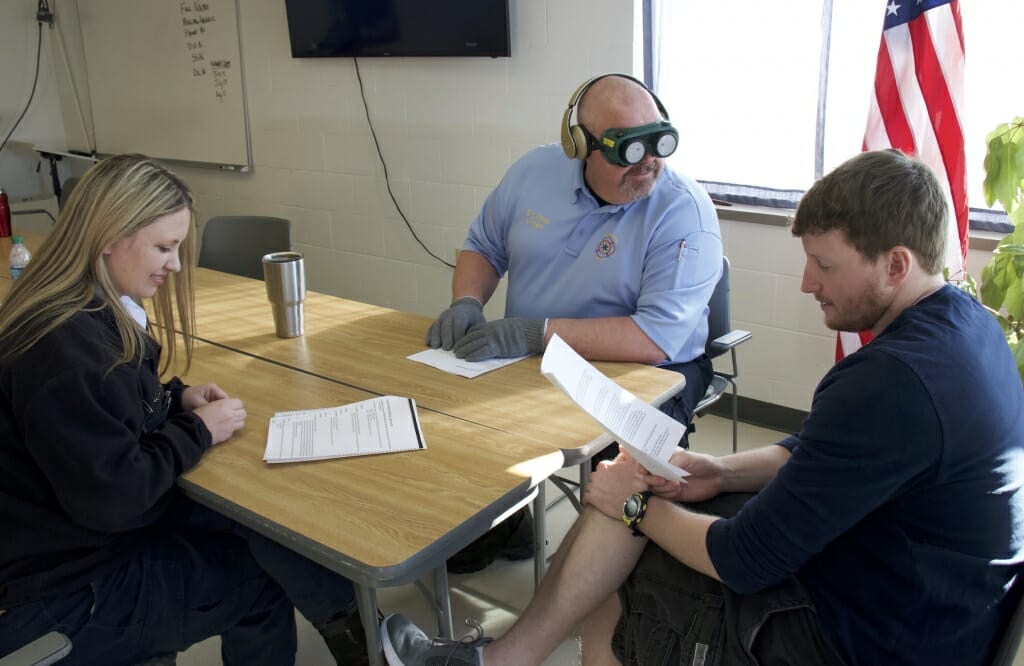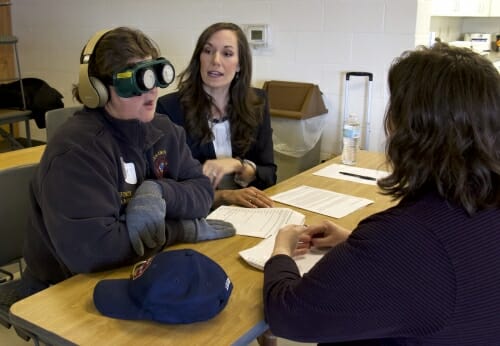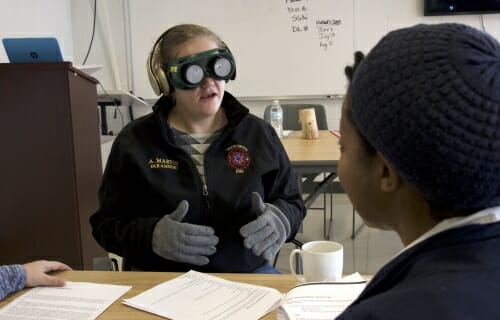Dementia: Can a “friendly visit” play a role in keeping seniors safe at home?

Lisa Antoniewicz (left), deputy chief of Deer-Grove EMS, plays caregiver as her colleague, Matt Mickelson, right, takes the role of a doctor short of time. EMS chief Eric Lang, center, wears sensory deprivation gear to mimic the feeling of dementia. Photo by David Tenenbaum
No lives were at stake at a rural emergency medical services headquarters north of Cottage Grove, Wisconsin, on this Tuesday morning – at least, not as they are after a heart attack or a car crash.
But in another sense, lives were indeed at stake, as five paramedics from Deer-Grove Emergency Medical Service completed the last of 12 hours of training intended to help them become “friendly visitors” with seniors showing signs of dementia.
“The idea is to use people who are already considered helpers in the community, to establish connections between older adults who may be in the early stages of dementia, with existing community services,” says Molly Schroeder, community dementia programs manager at the Wisconsin Alzheimer’s Institute. “The overall purpose is to support people living with dementia to stay in their homes as long as possible by filling gaps in community supports.”
Art Walaszek, a geriatric psychiatrist at UW–Madison, is principal investigator on the Dementia Capable Wisconsin grant at the Alzheimer’s Institute in the University of Wisconsin School of Medicine and Public Health.
People with dementia call emergency medical services more than other older adults, sometimes for non-emergencies. The EMS Visitor Program will evaluate whether those calls are reduced once seniors connect to appropriate support in the community. The Deer-Grove program builds on lessons from an earlier training at Fitch-Rona EMS, headquartered in Verona.
Today’s training began with a dementia simulation, led by Sarah Endicott, a geriatric nurse practitioner at the UW–Madison School of Nursing. The purpose was to immerse EMS staff in the experience of dementia. Each group had “Taylor,” a person with possible dementia, a time-pressed doctor, and a caregiver. To simulate the limits that often accompany dementia, “Taylor” wore goggles allowing pinhole vision, and earphones supplying confusing noise.

Left to right, paramedic Wendy Lasko, dementia programs manager Molly Schroeder, and Sara Sprang, case manager at the McFarland Senior Center, during a simulated encounter between an older adult with dementia, a caregiver, and a doctor. Photo by David Tenenbaum
After playing Taylor, paramedic Wendy Lasko attested that the equipment blocked communication. “You can’t see the person you are talking to… and you are worried you are wrong, you don’t know the answer, or why you are there, so you just say, ‘Okey dokey.’”
After a quick tutorial on some basic principles of communicating with someone with dementia (face the other person, make eye contact, speak clearly, smile and use gestures, be patient, get the person’s attention by using their name), the groups repeated the scenario.
The tips helped, said Alexa Martin, a Deer-Grove paramedic: “When I was the patient, every time it was about me, my caregiver said, ‘Okay, Taylor… .’ That got my attention; I knew it was relevant to me.”

Paramedic Alexa Martin starts a dementia simulation with Sheryl Coley, a researcher on the EMS Visitor project. Photo by David Tenenbaum
The training answered real needs, Lasko said. “I wanted to learn new tools. I may be with people who have dementia and may or may not know it. We have memory care facilities in the community, and those people get sick, too, and we go on those calls. It would be nice to be able to communicate better with them, and draw out more information so I can advocate for them at the ER.”
“Even though they can’t follow the whole conversation, you were still treating them as adults,” observed Endicott.“ In dementia, it’s common to feel that everyone is talking about them, not talking to them.”
The EMS Visitor Program is intended to connect older adults with dementia to supportive programs in the community, making it easier for them to stay at home.
Eric Lang, chief of the Deer-Grove EMS, said the training gave multiple benefits. “Any time we can help improve overall health in the community, decrease demand on the health care system, I’m interested. If we visit casually, that may decrease the use of emergency services, and save us for folks who need an ambulance for the gunshots and motorcycle crashes. In fact, I think we are more likely to interact with patients with dementia than on the kind of calls that make the news.”
The idea of participating in the visitor program training bubbled up from the staff, Lang said. “It provides an opportunity for our folks to interact with the community in a positive light. Calling for emergency services is potentially your worst day ever, but in this case, we can go and visit, interact, and maybe make their lives better for the long term.”
This project of the Wisconsin Alzheimer’s Institute is supported by a grant from Administration for Community Living at the U.S. Department of Health and Human Services.

